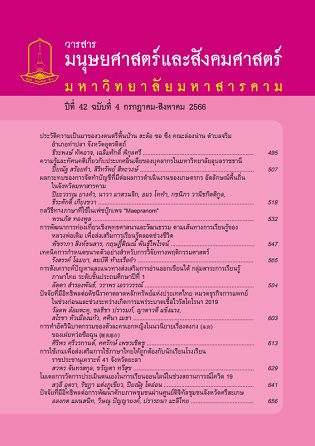Sample Size Determination Techniques for Behavioral Sciences Research
Main Article Content
Abstract
The purposes of this article are to inform readers to : 1) gain better understanding regarding the sample size techniques for behavioral science research, 2) know how to determine the sample size for a classic behavioral sciences research, and 3) know how to make a decision on the research sample size program for behavioral sciences research through an online program. The author has constructed to body of knowledge from synthesizing a wide range of resources such as academic documents, books, textbooks and articles on a sample size for behavioral science research. At the beginning of this article, the author will Provide the information on approaches to sample size determination in behavioral research. Next, the article will present the research sample size determination using formulas, tables, and online programs from a variety of institutes. Last but not least, the research sample size determination using statistical analysis techniques for a large samples size such as factor analysis and structural equation modeling (SEM) is presented. It is the author’s intention that the readers are able to apply all knowledge most importantly to conduct a research with a high quality and reliability as well as to improve their body of knowledge on research methodology.
Article Details
References
Ahn, C., Heo, M., & Zhang, S. (2015). Sample size calculations for clustered and longitudinal outcomes in clinical research. CRC Press.
Bentler, P. M., & Yuan, K.-H. (1999). Structural equation modeling with small samples: Test statistics. Multivariate Behavioral Research, 34 (2), 181- 197.
Campbell, M. J., Machin, D., Tan, S. B., & Tan, S. H. (2018). Sample size tables for clinical, laboratory and epidemiology studies (4th ed). John Wiley & Sons Ltd.
Clinical & Translational Science Institute. (2023). Sample size calculators. Clinical Research Program at UCSF.
Cochran, W. G. (1977). Sampling techniques. John Wiley and Sons, Inc.
Cozby, P. C., & Bates, S. C. (2018). Methods in behavioral research. McGraw-Hill Education.
Creative Research Systems. (2023). Sample size calculator. Creative Research Systems. website.
Christensen, L. B., Johnson, R. B., & Turner, L. A. (2014). Research methods, design, and analysis. Pearson International Publishing.
Dattalo, P. (2008). Determining sample size balancing power, precision, and practicality. Oxford University Press.
Fielding, N. (2017). The sage handbook of online research methods (2nd ed). SAGE Publications Ltd.
Gravetter, F. J. (2018). Research methods for the behavioral sciences. Cengage Learning.
Gravetter, F., Forzano, L-A., & Rakow, T. (2021). Research methods for the behavioural sciences. Cengage Learning EMEA.
Gravetter, F. J., & Forzano, L. B. (2011). Research methods for the behavioral sciences (4th ed). Cengage Learning.
Hair, J. F., Black, W. C., Babin, B. J., & Anderson, R. E. (2019). Multivariate data analysis (8th ed). Cengage Learning.
Härdle, W. K., & Simar, L. (2019). Applied multivariate statistical analysis (5th ed). Springer International Publishing.
Israel, G. D. (1992). Determining sample size. University of Florida Cooperative Extension Service, Institute of Food and Agriculture Sciences.
Kieser, M. (2020). Methods and applications of sample size calculation and recalculation in clinical trials. Springer.
Krejcie, R.V., & Morgan, D. W. (1970). Determining sample size for research activities. Educational and Psychological Measurement.
Ledford, J. R. (2018). Single case research methodology applications in special education and behavioral sciences. Routledge.
Leavy, P. (2023). Research design: Quantitative, qualitative, mixed methods, arts-based, and community-based participatory research approaches (2th ed). The Guilford Press.
Maple Tech International LLC. (2023). Sample size calculator. Maple Tech International LLC operates the calculator.net. https://www.calculator.net/sample-size-calculator.html
Patten, M. L, & Newhart, M. (2018). Understanding research methods. Taylor and Francis.
Pitard, F. R. (2019). Theory of sampling and sampling practice (3rd ed). CRC Press.
Privitera, G. J. (2016). Research methods for the behavioral sciences (2nd ed). Sage Publications, Inc.
Odeh, R. E., & Fox, M. (2020). Sample size choice charts for experiments with linear models. CRC Press.
Qualtrics. (2023). Sample size calculator. customer experience management (CXM). https://www.qualtrics.com/blog/calculating-sample-size/
Raosoft. (2023). Sample size calculator. Raosoft, International Corporation.
Rosei, F., & Johnston, T. (2005). Survey sampling: Theory and methods. CRC Press.
Schoot, R., & Miočević, M. (2020). Small sample size solutions a guide for applied researchers and practitioners. Routledge.
Tabachnick, B. G., & Fidell, L. S. (2007). Using multivariate statistics (5th ed). Pearson International Publishing.
Tabachnick, B. G. & Fidell, L. S. (2012). Using multivariate statistics (6th ed). Pearson International Publishing.
Tabachnick, B. G. & Fidell, L. S. (2014). Using multivariate statistics. Pearson International Publishing.
Tabachnick, B. G., Fidell, L. S., & Ullman, J. B. (2018). Using multivariate statistics (7th ed). Pearson International Publishing.
The SAS Technical Team Writers. (2004). Getting started with the SAS power and sample size application. SAS Institute Inc.
Verma, J. P., & Verma, P. (2020). Determining sample size and power in research studies a manual for researchers. Springer Singapore.
Yamane, T. (1967). Elementary sampling theory. Prentice-Hall.


